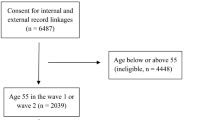Abstract
Factors affecting long-term absenteeism for non-accident-related sickness leave in a large, remotely located factory (Dead Sea Industry, Israel) were evaluated. About 10% (89 persons) of the workers were found to be on sick leave for more than 20 days/year. This group was designated as high absence workers (HAW). Most of the sickness absence were for repeated short-term leaves due to intercurrent diseases, rather than for continuous periods related to a major or single illness. Average cumulative duration of sick leave in this group was 54 days/year. The average number of spells was 11 per year (4.9 days/spell). There were significantly more HAW among skilled (relative risk, R.R. = 1.6) workers or shift workers (R.R. = 1.3), compared to white collar workers. There were significantly fewer HAW among workers 35–49 years of age (7.6%) than among younger (12.5%) or older workers (13.8%). Except for possible hearing loss in one worker, no occupationally related illness was identified. Sixty-six percent of the HAW took many sick leaves, over 20 days during the year following the study year, and 52% of this group took over 20 days in the preceding year (usually for minor diseases or complaints). This pattern of long-term sickness absence indicates that various socioeconomic factors determine HAW to a greater extent than immediate occupational risks or health problems.
Similar content being viewed by others
References
Bews DC (1972) Monitoring disability absence in an employee group. J Occup Med 14:911–917
Brooke PJ (1986) Beyond the stress and Rhodes model of employee attendance. Acad Manag Rev 11:345–361
Chevalier A, Luce D, Blanc C, Goldberg M (1987) Sickness absence at the French National Electric and Gas Company. Br J Ind Med 44:101–110
Dimberg L (1989) Sickness absenteeism in an engineering industry — an analysis with special reference to absence for neck and upper extremity symptoms. Scand J Soc Med 17:77–84
Dittach JE (1979) Organizational equity perceptions, employee job satisfaction and departmental absense and turnover rates. Organiz Behav Human Performance 24:29–40
Enterline PE (1986) Social causes of sick absence. Arch Environ Health 12:467–473
Koller M (1979) Psychosocial problems and psychosomatic symptoms of shift and day workers. Arch Hyg Rad Toxicol 30:1395–1406
Lofvander M, Papastavrou D (1990) Clinical factors, psychosocial stressors and sick-leave patterns in a group of Swedish and Greek patients. Scand J Soc Med 18:133–138
Lokander S (1962) Sick absence in a Swedish company: a sociomedical study. Acta Med Scand 171:377–390
Luz Y, Green MS (1992) Sickness absence in 21 industrial plants in Israel (1986–87). The cordis study. Isr J Med Sci 28:650–658
Maeda K (1973) A trial analysis of sick absence in industry by the use of factor analysis. Ind Health 11:19–26
Maeda K, Tanaka S, Maeda K (1979) A note on factors influencing absenteeism. A brief comment on the effect of uncertainty of unemployment. Arch Hyg Rad Toxicol 30:1345–1349
McKweon KD (1991) Sickness absence. Medical, non-medical or both? Occup Health Lond 43:116–117
Schaffer A, Bar-Nets M (1979) L'Absente'isme a' cause de maladies et d'accidents du travail, probleme d'importance primaire de l'industrie moderne. Arch Hyg Rad Toxicol [Suppl] 3:1351–1361
Author information
Authors and Affiliations
Additional information
This work was partially supported by a grant from the Committee of Prevention, the Israeli Ministry of Labor
Rights and permissions
About this article
Cite this article
Eyal, A., Carel, R.S. & Goldsmith, J.R. Factors affecting long-term sick leave in an industrial population. Int. Arch Occup Environ Heath 66, 279–282 (1994). https://doi.org/10.1007/BF00454367
Received:
Accepted:
Issue Date:
DOI: https://doi.org/10.1007/BF00454367




